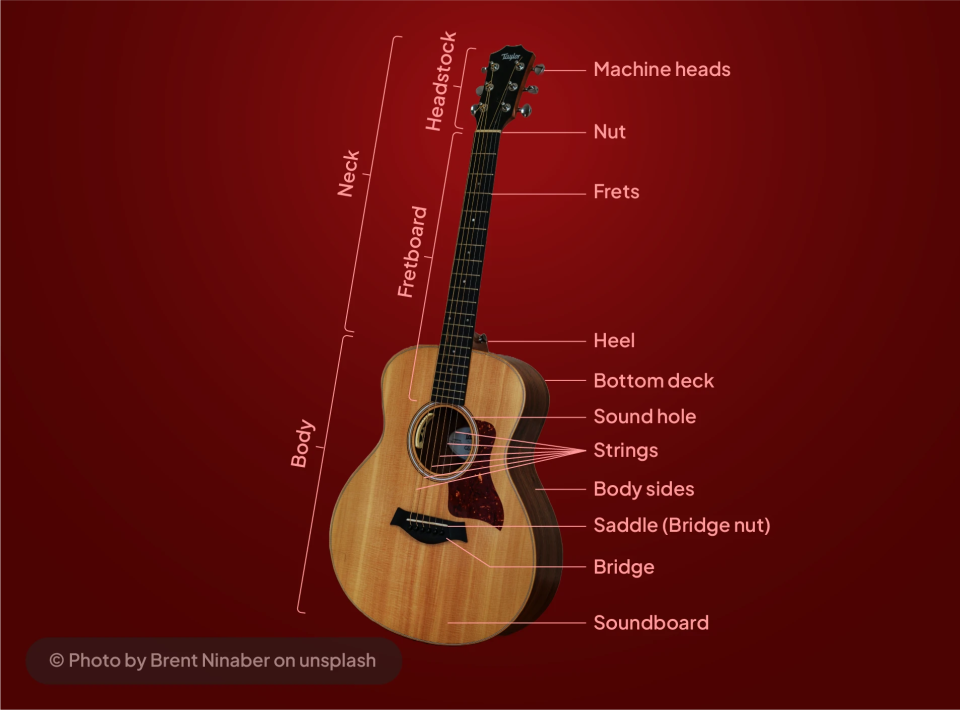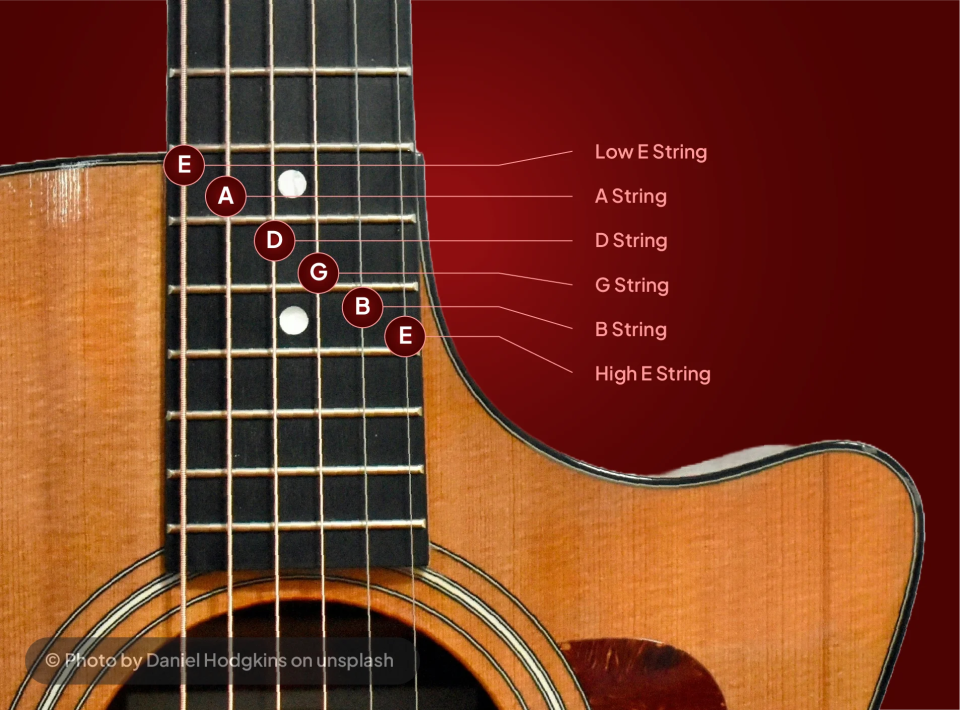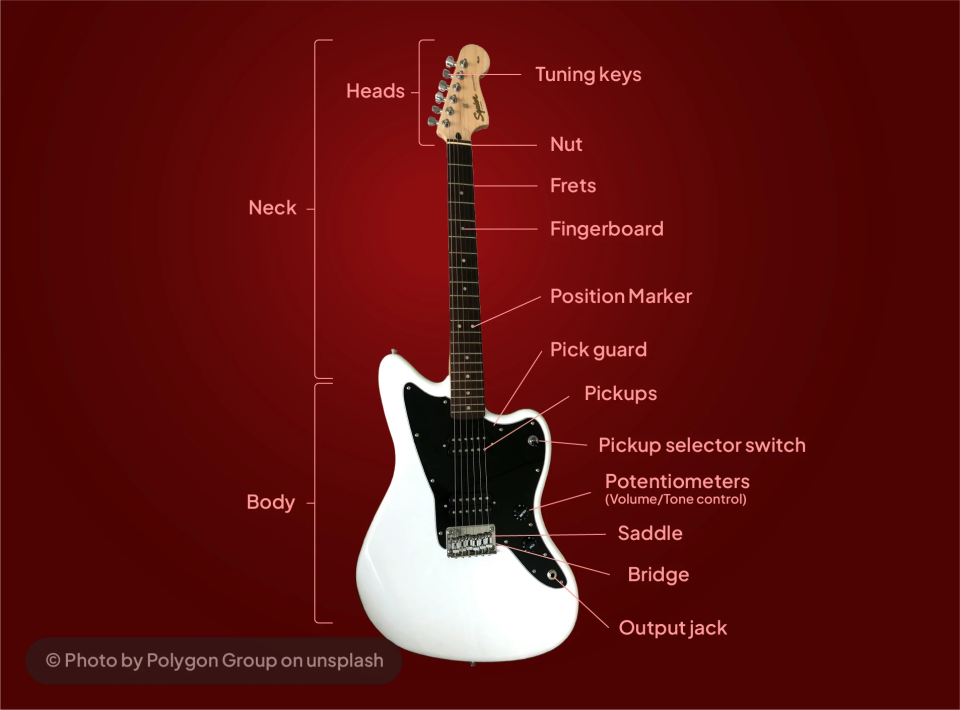Acoustic Guitar vs Electric Guitar: Which One to Choose?
Learning guitar is one of the most aspirational musical instruments among music enthusiasts. It has a universal appeal in terms of the diverse musical styles it can be a part of. But one question comes to the mind of new learners is which one to choose - acoustic guitar vs electric guitar.
In this blog, we will analyse the exact differences between acoustic guitar and electric guitar, their unique characteristics and what should be the correct criteria for choosing the right guitar for beginners.
Acoustic Guitar for Beginners - Pros and Cons

Pros: Why should you pick the acoustic guitar as a beginner?
i.) Simplicity That Lets You Focus on Playing
One of the biggest advantages of starting with an acoustic guitar is its simplicity. You don’t need any amps, cables, or effects pedals. Just pick it up and play. For someone new to the instrument, this straightforward setup makes learning much less overwhelming.
You can focus on what truly matters — how to play guitar for beginners — without getting caught up in figuring out gear or technical settings.
ii.) Honest, Organic Sound Helps Build Better Technique
Acoustic guitars give you a clean, natural sound. There's no distortion or digital effects to mask your playing. This means you hear exactly what you're doing — every strum, every pluck, every mistake.
That kind of raw, unfiltered feedback is incredibly valuable when you're learning. It trains your ear and makes you more aware of dynamics, tone, and technique right from the beginning.
iii.) Finger Strength and Dexterity Develop Faster
Yes, acoustic guitars have slightly higher string tension and can be harder to press down at first. But that challenge is actually a blessing in disguise.
Your fingers will grow stronger and more precise more quickly than if you had started on the softer, lighter strings of an electric guitar. Once you build that strength, switching to electric becomes much easier and more comfortable.
iv.) Builds a Solid Technical Foundation
Learning on an acoustic guitar forces you to play cleanly. There's no hiding behind effects or amp reverb. If something sounds off, you’ll know it — and that awareness helps you fix your technique early.
Over time, this builds a strong foundation that will serve you well, whether you stick with acoustic or move to electric later.
v.) Great for All Musical Goals
Whether you want to become a shredding lead guitarist or just play and sing some of your favorite pop songs, starting with an acoustic guitar gives you the skills you’ll need. It’s versatile enough to support any direction you want to go in.
Plus, the ability to play a song with just your guitar and voice is empowering — and incredibly motivating.
vi.) More Convenient and Budget-Friendly
Acoustic guitars are more portable, affordable, and beginner-friendly overall. You can take them anywhere, practice anytime, and you don’t need extra gear to get started.
For someone just stepping into the world of music, that freedom and convenience can make all the difference in staying consistent with practice.
vii.) A Smooth Transition to Electric Later
Starting with acoustic makes switching to electric much easier. You’ll already have the finger strength, ear training, and technique in place. When you do move on to electric, effects and tone controls will feel like fun additions — not necessary crutches.Think of the electric guitar as an extension of the foundation you built on acoustic. That foundation is what makes you a confident, well-rounded player.
Cons: Reasons Why Beginners Avoid the Acoustic Guitar
i.) Tougher on the Fingers
One of the most immediate challenges is physical discomfort. Acoustic guitars (especially those with steel strings) typically have heavier string tension and higher string action than electrics. This means you’ll need to press down harder, which can lead to sore fingertips in the beginning. It’s a normal part of learning, but it can be discouraging for some new players.

ii.) Limited Sound Variety
Acoustic guitars have a beautiful, natural tone — but they offer limited tonal flexibility. You can’t add distortion, delay, or other effects unless you get an acoustic-electric and plug into a processor. If you're excited by experimental sounds or genre-specific tones (like heavy metal or funk), an acoustic might feel a bit limiting.
iii.) Less Forgiving of Mistakes
Acoustic guitars produce a very clean and direct sound, which is great for building good technique, but also means that every little mistake is audible — buzzing strings, missed frets, uneven strumming, etc. For beginners, this can be frustrating, especially when you're just trying to get a basic tune out.
iv.) Higher Physical Demands
Not only do you need more finger strength, but barre chords and stretches can also feel harder on acoustic guitars due to the wider necks (especially on classical models) and overall tension. This is more noticeable for younger players or those with smaller hands.
v.) Less Quiet for Practice
Unlike an electric guitar, which can be played through headphones, acoustic guitars can’t be silenced. If you live in a shared space or want to practice late at night, this might be a concern.
vi.) Portability Can Be Tricky (for Larger Models)
While acoustic guitars are technically more portable because they don't need amps or gear, full-sized dreadnoughts or jumbo acoustics can feel bulky for smaller players or kids. They’re not as easy to tuck away or carry around as you might think.
vii.) Restringing Can Be Intimidating
Restringing an acoustic guitar — especially a steel-string model — can feel a bit more fiddly at first. While this isn’t a major hurdle, beginners often find the first few string changes a bit stressful without guidance.
Electric Guitar for Beginners - Pros and Cons
Pros - Why Should You Pick the Electric Guitar as a Beginner?
i.) Easier to Play Physically
Electric guitars generally have lighter strings, a lower string action, and thinner necks compared to acoustics. This means they're easier on your fingers, especially in the early weeks when finger soreness is common. Chords and scales feel smoother and more forgiving.
ii.) Wide Range of Sounds
Electric guitars give you access to a huge variety of tones — clean, distorted, crunchy, ambient, jazzy, and more — all controlled through amps, pedals, or built-in effects. It’s perfect if you want to experiment or dive into different genres like rock, blues, metal, or jazz.
When it comes to playing guitar scales for blues, the electric guitar is generally considered the best choice. They also offer great playability for fast runs, scales, and chord melody playing, making them ideal for jazz solos. Metal wouldn't exist without the electric guitar's ability to produce distorted, aggressive tones. Power chords, riff-based structures, and guitar solos are defining features of rock music, made possible and effective through electric guitars.
iii.) Quiet Practice with Headphones
Using a headphone-compatible amp or an audio interface, you can practice quietly without disturbing anyone. This makes the electric guitar especially beginner-friendly for people living in apartments or shared spaces.
iv.) Motivating and Fun
For many beginners, plugging in and hearing that classic rock tone or gritty distortion is simply more exciting. If the sound inspires you to keep playing, that's a huge win — because consistent practice is what really matters.
v.) Easy Transition to Other Styles
Once you're comfortable on electric, it's fairly easy to switch to acoustic later. You'll already have the technique, finger strength, and musical foundation in place.
Cons - Reasons Why Beginners Avoid the Electric Guitar
i.) Requires Additional Gear
Unlike an acoustic, an electric guitar isn’t self-contained. You'll need an amplifier, a cable, possibly a strap, picks, and maybe even a tuner or effects pedal. This adds to the cost and setup time.
ii.) Can Be Distracting
Having access to a variety of tones and effects can sometimes be overwhelming. Instead of focusing on learning chords or scales, beginners may get caught up in tweaking settings or playing with distortion, which can delay progress in core skills.
iii.) More Maintenance and Setup
Electric guitars can require more setup and adjustment, from amp settings to pickup selector switches. Plus, managing volume, gain, and tone knobs can be confusing at first if you’re completely new.
iv.) Technique Hiding Behind Effects
With distortion and reverb, it’s sometimes easy to mask poor technique. A sloppy chord might sound okay through heavy effects, which can slow down your learning curve if you’re not listening closely or practicing cleanly.
Wrapping Up - Acoustic Guitar vs Electric Guitar
The acoustic guitar is the guitar ever known to man and the electric guitar was a natural evolution. It emerged as a response to the acoustic guitar’s limitations in volume and projection, especially in ensemble settings.
But instead of replacing the acoustic guitar, the electric guitar expanded the instrument's possibilities. It enabled greater volume for live performances, creative sound manipulation through effects and amps, and inspired new playing techniques like bending, tapping, and shredding.
When it comes to which one should a beginner choose between acoustic versus electric guitar - there’s no one-size-fits-all answer to it. If you’re drawn to simplicity, songwriting, or unplugged styles like folk, classical, or acoustic pop, starting with an acoustic guitar is a great choice. It helps you build strong foundational technique, trains your ear, and strengthens your fingers early on — all without the need for additional gear.
On the other hand, if you're excited by rock, blues, metal, or you’re eager to explore different tones and effects, the electric guitar offers a smoother playing experience with more creative flexibility. It’s easier on the fingers and allows for quiet practice with headphones, which is ideal in shared or noise-sensitive spaces.
Ultimately, the best beginner guitar is the one that motivates you to keep playing. Whichever you pick, consistent practice and passion will matter more than the type of guitar. Start where you feel most inspired — and you’ll be on the right path.
If you want to learn guitar, you can explore online guitar classes.
Yes, many fundamental techniques like chords, scales, and strumming patterns apply to both. However, some techniques are easier or more common on electric guitars — such as string bending, tapping, and fast soloing — because of their lower string tension. Meanwhile, acoustic playing often emphasizes fingerpicking, open chords, and dynamic control since the sound is more exposed.
It can be, depending on your setup. Acoustic guitars naturally balance well with vocals, making them ideal for singing and strumming. Electric guitars often require amplification and tone tweaking, which may overpower your voice unless mixed properly or played clean. For singer-songwriters or solo performers, acoustic is usually more convenient.
Absolutely. Many guitarists start with either type and transition over time. However, starting on acoustic builds finger strength and cleaner technique, while starting on electric makes playing physically easier at first. Once you have a solid foundation, switching is smooth, though you'll need to adjust to things like neck width, string tension, and playing style.
Electric guitars are often physically easier for younger learners due to their smaller size, lighter weight, and softer strings. Acoustic guitars (especially full-sized dreadnoughts) may feel bulky and harder to press. That said, there are smaller-sized acoustic guitars designed specifically for kids. The best choice depends on the child's interest and hand size.
Electric guitars generally require more setup and care. You’ll need to manage things like amp settings, cables, pickups, and occasionally deal with electronic issues. Acoustic guitars, while simpler, are more sensitive to humidity and temperature changes, which can affect the wood. So, both require maintenance, just in different ways.















